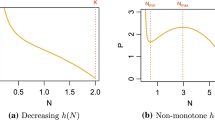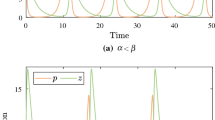Abstract
In previous work (Freedman and Wolkowicz, 1986;Bull. math. Biol. 48, 493–508) it was shown that in a predator-prey system where the prey population exhibits group defence, it is possible that enrichment of the environment could lead to extinction of the predator population.
In this paper a third population is introduced and criteria are derived under which persistence of all populations will occur. In particular, criteria for a superpredator and for a competitor to stabilize the system in the sense of persistence are analyzed.
Similar content being viewed by others
Literature
Butler, G. J., H. I. Freedman and P. E. Waltman. 1986. “Uniformly Persistent Systems”.Proc. Amer. Math. Soc. 96, 425–430.
— and P. Waltman. 1986. “Persistence in Dynamical Systems”.J. Diff. Eqns. 63, 255–263.
Freedman, H. I. and J. W.-H. So. 1985. “Global Stability and Persistence of Simple Food Chains”.Math. Biosci. 76, 69–86.
— and —. 1984. “Persistence in Models of Three Interacting Predator-Prey Populations”.Math. Biosci. 68, 213–231.
— and —. 1985. “Persistence in a Model of Three Competitive Populations”.Math. Biosci. 73, 89–101.
— and G. S. K. Wolkowicz. 1986. “Predator-Prey Systems with Group Defence: The Paradox of Enrichment Revisited”.Bull. math. Biol. 48, 493–508.
Holmes, J. C. and W. M. Bethel. 1972. “Modification of Intermediate Host Behaviour by Parasites”.Zool. J. Linn. Soc., Suppl. 1,51, 123–149.
Hutson, V. 1984. “Predator Mediated Coexistence with a Switching Predator”.Math. Biosci. 68, 233–246.
May, R. M. and S. K. Robinson 1985. “Population Dynamics of Avian Brood Parasitism”.Amer. Nat. 126, 475–494.
Mischaikow, K. and G. S. K. Wolkowicz. 1986. “A Predator-Prey Model Involving Group Defence: A Connection Matrix Approach”. InMathematical Proceedings of the Research Conference Trieste (L. J. Gross, T. B. Hallam and S. A. Levin, eds.), World Sci. Publ.
Rescigno, A. and K. G. Jones. 1972. “The Struggle for Life: III—A Predator-Prey Food Chain”.Bull. math. Biophys.,34, 521–532.
Rosenzweig, M. L. 1971. “Paradox of Enrichment: Destabilization of Exploitation Ecosystems in Ecological Time”.Science 171, 385–387.
Tener, J. S. 1965.Muskoxen, Ottawa: Queen's Printer.
Wolkowicz, G. S. K. 1988. “Bifurcation Analysis of a Predator-Prey System Involving Group Defence”.SIAM J. Appl. Math. 40, 1–15.
Yang, R. D. and A. E. Humphrey. 1975. “Dynamics and Steady State Studies of Phenol Biodegeneration in Pure and Mixed Cultures”.Biotechnol. Bioengng. 17, 1211–1235.
Author information
Authors and Affiliations
Additional information
Research partially supported by the Natural Sciences and Engineering Research Council of Canada, Grant No. NSERC A 4823.
This research was carried out while the author was a visiting scholar at the University of Alberta.
Rights and permissions
About this article
Cite this article
Freedman, H.I., Hongshun, Q. Interactions leading to persistence in predator-prey systems with group defence. Bltn Mathcal Biology 50, 517–530 (1988). https://doi.org/10.1007/BF02458850
Received:
Revised:
Issue Date:
DOI: https://doi.org/10.1007/BF02458850




